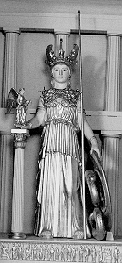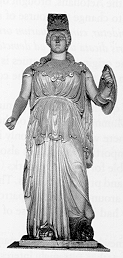| The forms and modes of Greek culture were introduced to Rome at an early date; the first temples to Greek cults appeared in the 5th Century BC. The Romans had contacts with numerous 'Poleis' (city states) in South Italy, (ie Locri) and the major cultural centres of Greece and Asia Minor. | The assimilation of the motifs of Greek art is noticeable from the 4th Century BC onwards. It has been suggested, because of the precise nature of the art produced, that Greek craftsmen were operating in Rome at this time, or that Greek copies, including moulds and plaster casts, were readily available. Greek archetypes were adopted right through the Republican to the Augustan age. The first temple to be built on a Greek plan in Rome was the Magna Mater on the Paletine Hill, in 204 BC. |
| Workshops in Rome from 100 AD were reviving the motifs and formal elements of Athenian Sculpture from the 5th and 4rth Centuries BC. These were not just reproductions, but a re- elaboration of classical prototypes in order to produce new works. |
 |
On the left is a model of Pheidias' Athena Parthenos from the Parthenon in Athens, dated around 450 B.C. This can be compared to the Roman statue of Athena on the left, dating from 150 AD. This shows the similarity of the statues being produced in Rome to those of Ancient Greece. It has been suggested that the Boston Throne was a product of such a workshop. However, no similar works of the classicizing period have been found. |
 |